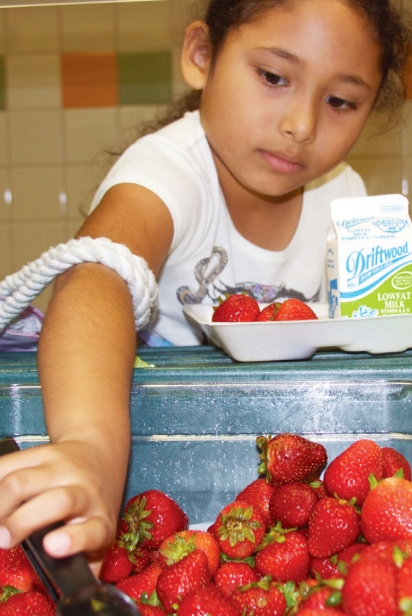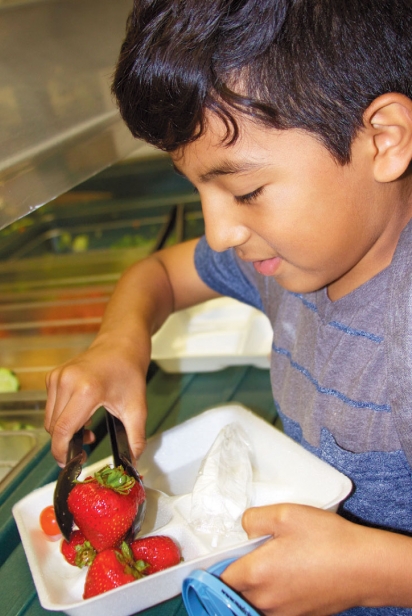Back to Scratch
Oxnard School District students’ plates are changing
Cinnamon-spiced granola pork pozole rojo tomato salsa elote corn salad barbecue chicken drums oven-baked French toast herb-roasted potatoes
What could be menu highlights from a chic café are, instead, a sampling of made-from-scratch dishes appearing on elementary students’ trays throughout the Oxnard School District this school year.
It’s a big change from a few years ago when the pizzas, grilled cheese sandwiches and pasta sauces all arrived in big frozen boxes waiting to be thawed, heated and scooped onto a passing tray.
“We signed up to be cooks. That’s our job description,” says Maria Lucero, child nutrition coordinator at Thurgood Marshall Elementary School, who participated in the scratch cooking culinary training, a boot camp of sorts, this past summer for district employees.
At the rigorous—yet tasty—two-day workshop, the cooking staff executed over a dozen new recipes, while brushing up on nutrition, reducing food waste and “marketing” healthy menu items to children. (Oxnard and other districts follow the nutrition guidelines of the Healthy Hunger-Free Kids Act of 2010.)
Real revolutions in school food don’t come prepackaged and frozen; they require patience and perseverance. Change must come from the top, and that’s what’s happening at OSD. Director of Child Nutrition Suzanne Lugotoff, a dietitian and school food service and nutrition specialist, and Assistant Director Allison Cairns, a graduate of the Culinary Institute of America, are committed to providing opportunities “for our student and staff communities to take their taste buds on an adventure.”
“A culture of ‘healthy lifestyle,’” Lugotoff explains, “encourages moderation and variety. By enhancing and expanding the variety of foods provided at school, the Child Nutrition Department can strive to impact one facet of creating healthy lifestyle choices and habits.” (Change is happening at districts throughout the county. See sidebar on page 34 to learn more.)
The district’s 21 schools educate nearly 17,000 students, 83% of whom qualify for free and reduced-price meals. Lugotoff and Cairns oversee about 150 kitchen employees who serve 4,000 breakfasts, 12,000 lunches, 700 snacks and 1,700 suppers on a daily basis during the school year.
It’s the kind of large-scale operation that, in many ways, explains the nation’s shift away from scratch cooking and into frozen, processed foods decades ago. Feeding thousands of kids meals made by hand and not machine is no easy task. And where budgets are tight, scratch- made foods and fresh ingredients can be lead weights dragging school finances into the red.
Lugotoff and Cairns, however, are convinced healthy food and healthy budgets are not mutually exclusive; in fact, they argue that the two are symbiotic. In a district like Oxnard where the vast majority of kids qualify for assistance, increased participation increases overall reimbursement. Encouraging kids to experience what comes out of the cafeteria results in less food waste, which can potentially reduce subsidizing from the district’s general fund.
Weaning students away from junk food like Hot Cheetos toward organic cauliflower can be a challenge. So engaging cafeteria staff is a priority, say Lugotoff and Cairns. At OSD, “child nutrition workers” serve the meals, excited to see kids eat what they’ve prepared from scratch. The cafeteria is a learning environment, Cairns emphasizes. “I tell the staff that they’re cafeteria teachers, and they’re teaching students how to eat.”
Lugotoff is working to instill a “take what you want and eat what you take” philosophy in the lunch line. Key to this is exposing kids to new foods and getting them to lengthen the list of foods they like.
Esteban Varela, kitchen coordinator at Juan Soria Elementary School, brought a culinary degree from Oxnard College and years of restaurant experience to his job. He embraces the new culture Lugotoff and Cairns are implementing.
He also uses the salad bar to expand students’ culinary horizons. Some days, he has his staff leave the greens on the carrots, and he delights in explaining to kids that this is what carrots look like straight out of the ground. When he put purple cauliflower in the salad bar, student after student asked if he’d dyed the vegetable.
Introducing more fruits like persimmons, pineapple and blackberries and limiting the standard oranges and apples is another of Varela’s strategies. When fresh strawberries appear on the salad bar, students pile them high on their lunch trays. It dawned on Varela early in his time with OSD that strawberries are grown across the street. “Why aren’t we using them?” he wondered.
Local produce can cost more, but Varela pays attention to the prices and highlights local fruits and vegetables when he can. Students returned for seconds and thirds when he served a farm-fresh kale Caesar salad, and when his staff had fresh corn, they used it in a salad recipe with mayonnaise, cheese and paprika inspired by Mexican street vendor corn.
At Thurgood Marshall, Lucero is proud of the steps she and staff have made away from soul-less food prep. The veggies used to arrive pre-cut; now staff members chop before serving. They also serve more foods directly onto student trays, rather than setting out scores of prepacked Styrofoam cups. This change, Varela agreed, allows for more interaction between student and educator by prompting conversation and eliminating the “mystery cups” that discourage palate expansion.
OSD capitalized on the slower pace of the summer months in its push toward scratch cooking, since the district’s cafeterias serve fewer kids and there’s more time for training. Cairns was apprehensive about how the staff would respond to the difficulty of integrating new methods of cooking from scratch, but her staff brimmed with suggestions and enthusiasm.
Yes, the program is more labor intensive, but it’s worth it, Lucero says. “The payoff is seeing excited kids eat our food and not waste it.”
SERVING UP THE FARM TO SCHOOL MOVEMENT
Connecting Ventura County students with local produce might seem simple. The county’s fertile soils grow fruits and veggies that feed kids on the other side of the country, why not the kids attending the school down the street?
This was the puzzle that Ventura Unified School District’s food and nutrition services department, parents and board members aimed to solve when they launched their Farm to School Program during the 2001–2002 school year. One of its first actions: putting the first salad bar in an elementary school.
Thanks to the right balance of elbow grease and vision, VUSD—along with Rio, Ojai, Hueneme and Oxnard elementary school districts—formed the Ventura County Farm to School collaborative in 2012. It now impacts thousands of students through school cafeterias, classrooms, gardens and farms, says Alise Echele, a registered dietitian nutritionist and the healthy schools project coordinator, food and nutrition services at VUSD.
“Food for Thought Ojai was one of the community groups at the forefront for the Farm to School program,” explains Lori Hamor, executive director of the Ojai nonprofit and co-chair of the Ventura County Farm to School steering committee. “On the school district side, the invaluable support and leadership from Ventura Unified School District—long recognized as a vanguard farm to school district in California—has enabled the program to thrive over the past six years.”
This countywide collaborative successfully integrates local produce and healthy eating education into eight school districts. More than half of the students in Ventura County benefit from this collaboration. VC Farm to School’s education and procurement committees work together to source local produce, as connecting growers to school cafeterias and classrooms is a key ingredient.
Though ours is a rich agricultural area—producing 442,192 tons of celery alone, according to the 2017 Ventura County Crop & Livestock Report—there was no easy way to systematically move produce from the farm into the local schools. “Farmers and cafeterias don’t necessarily speak the same language,” says Hamor. “VC Farm to School’s coordination and procurement support have landed produce from dozens of local farms on the menus of local schools.”
VUSD sources about 50% of its produce from farms within a 150-mile radius, and most of it comes from right here. Conejo Valley Unified School District primarily uses baked goods and produce sourced from Southern California.
Once local greens (and reds and purples) arrive on campus, the next challenge is creating enthusiastic appetites. Foods introduced and promoted in the classroom or grown in school gardens are more likely to be consumed from the salad bar and later in students’ homes.
The Harvest of the Month program supplies teachers with lesson plans around each month’s chosen fruit or vegetable. Cooking carts come to the classrooms and onto the playground for sampling and hands-on cooking activities. Students touch, smell, see and taste seasonal produce like kale, persimmons and jicama. Farmers visit schools to deliver classroom lessons, and students tour nearby farms.
“We see kids’ minds blown, their eyes opened to how delicious these foods are that are grown in Ventura County. It’s a myth that kids hate fruits and vegetables. They love them,” says Echele.
The goal is to change lifelong eating habits, says Kara Muniz, director of Food and Nutrition Services at VUSD. “Our district values the importance of offering local and seasonal produce every day to our students, which in turn also supports our local economy.”













